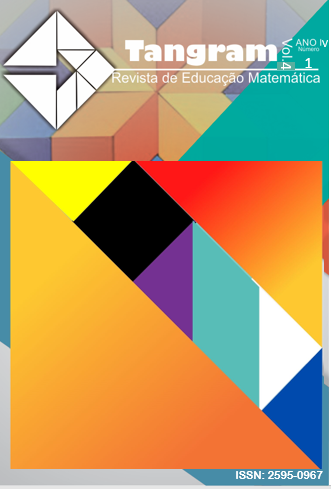Estrategias para promover la alfabetización gráfica a partir de información sobre la COVID-19 en Educación Secundaria
DOI:
https://doi.org/10.30612/tangram.v4i1.12560Keywords:
Alfabetización gráfica, Enseñanza, EvaluaciónAbstract
Este artículo relaciona la alfabetización gráfica con la transversalidad de los saberes estadísticos y matemáticos en situaciones de pandemia por coronavirus, las que pueden ayudar a los ciudadanos a comprender y afrontar crisis mundiales como la ocasionada por la COVID-19. Desde este prisma, la primera parte entrega antecedentes teóricos acerca de la codificación y descodificación de las representaciones gráficas, acorde a las taxonomías de Curcio y colaboradores y del informe GAISE, de manera de alfabetizar a los estudiantes del sistema escolar y, en la segunda parte, se presentan diversas actividades contextualizadas con datos reales de la COVID-19, en los cuales intervienen conceptos estadísticos, asimismo se presentan propuestas evaluativas.
Downloads
References
Arteaga, P., Díaz-Levicoy, D. y Batanero, C. (2018). Investigaciones sobre gráficos estadísticos en Educación Primaria: revisión de la literatura. Revista Digital Matemática, Educación e Internet, 18(1), 1-12.
https://doi.org/10.18845/rdmei.v18i1.3255
Batanero, C. Díaz, C., Contreras, J. M. y Arteaga, P. (2011). Enseñanza de la estadística a través de proyectos. En C. Batanero y C. Díaz (Eds.), Estadística con proyectos. Granada: Departamento de Didáctica de la Matemática
Batanero, C., Arteaga, P. y Ruiz, B. (2010). Análisis de la complejidad semiótica de los gráficos producidos por futuros profesores de educación primaria en una tarea de comparación de dos variables estadísticas. Enseñanza de las Ciencias, 28(1), 141-154.
Bertin, J. (1967). Semiologie graphique. París Gauthier-Villars.
Curcio, F. R. (1989). Developing graph comprehension. Reston: NCTM.
Erickson, T. (2006). Using simulation to learn about inference. En A. Rossman y B. Chance (Eds.), Proceedings of the 7th International Conference on Teaching Statistics (pp. 1-6). Salvador: IASE e ISI.
Eudave, D., Macías, A. C., Carvajal, M. y Muñoz, M. G. (2020). Comprensión de gráficas y tablas estadísticas de estudiantes para profesor de Educación Primaria. Zetetike, 28, e020007.
https://doi.org/10.20396/zet.v28i0.8656854
Friel, S., Curcio, F. y Bright, G. (2001). Making sense of graphs: critical factors influencing comprehension and instructional implications. Journal for Research in Mathematics Education. 32(2), 124-158.
Garfield, J. (1994). Beyond Testing and Grading: Using Assessment To Improve Student Learning. Journal of Statistics Education, 2(1), 1-10.
https://doi.org/10.1080/10691898.1994.11910462
Moore, D y Cobb, G. (2000). Statistics and mathematics: tension and cooperation. The American Mathematical Monthly, 107(7), 615-630.
https://doi.org/10.1080/00029890.2000.12005247
Rodríguez-Alveal, F. y Sandoval, P. (2012). Habilidades de codificacion y descodificacion de tablas y graficos estadisticos: un estudio comparativo en profesores y alumnos de pedagogia en enseñanza basica. Avaliação: Revista da Avaliação da Educação Superior (Campinas), 17(1), 207-235.
https://doi.org/10.1590/S1414-40772012000100011
Shaughnessy, J. M., Garfield, J. y Greer, B. (1996). Data handling. En A. J. Bishop, K. Clements, C. Keitel, J. Kilpatrick y C. Laborde (Eds.), International Handbook of Mathematics Education (pp. 205-237). Dordrecht, The Netherlands: Kluwer Academic Publishers.
UNESCO (2020). Impacto de la COVID-19 en la educación. Recuperado de: https://es.unesco.org/covid19/educationresponse
Wainer, H. y Spence, I. (2005). Graphical presentation of longitudinal data. En B. Everitt y D. Howell (Eds.), Encyclopedia of statistics in behavioral science. Hoboken: John Wiley & Sons.
Downloads
Published
How to Cite
Issue
Section
License
Authors must accept the publication rules when submitting the journal, as well as agree to the following terms:
(a) The Editorial Board reserves the right to make changes to the Portuguese language in the originals to maintain the cultured standard of the language, while respecting the style of the authors.
(b) Authors retain the copyright and grant the journal the right to first publication, with the work simultaneously licensed under the Attribution-NonCommercial-ShareAlike 3.0 Brazil (CC BY-NC-SA 3.0 BR) that allows: Share - copy and redistribute the material in any medium or format and Adapt - remix, transform, and create from the material. CC BY-NC-SA 3.0 BR considers the following terms:
- Attribution - You must give the appropriate credit, provide a link to the license and indicate whether changes have been made. You must do so under any reasonable circumstances, but in no way that would suggest that the licensor supports you or your use.
- NonCommercial - You may not use the material for commercial purposes.
- Sharing - If you remix, transform, or create from material, you must distribute your contributions under the same license as the original.
- No additional restrictions - You may not apply legal terms or technological measures that legally restrict others from doing anything that the license permits.
(c) After publication, authors are allowed and encouraged to publish and distribute their work online - in institutional repositories, personal page, social network or other scientific dissemination sites, as long as the publication is not for commercial purposes.






